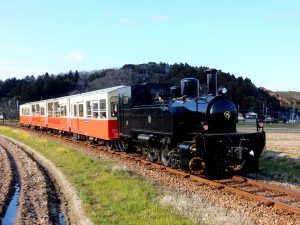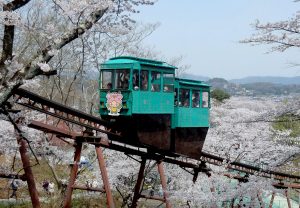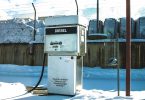Artificial trains, artificial destinations
The decreasing passenger numbers are felt especially by the railway companies in the country side. The so-called destination campaigns in order to attack passengers for viewing cherry blossoms, autumn leaves or the ocean are popular advertisement. Appealing alone is not enough, decided some companies and considered why not create artificial destinations. The so-called “Torokko” trains provide open windows where passengers smell the fresh air and have better photo chances. Their different design leads to a new travel experience according to the “slow life” movement. Similar like other railway companies, Kominato railway built their own original train, which is in fact a diesel engine appearing in steam locomotive design (see figure 10).

Figure 10: The Kominato “steamer” in fact is driven by a Volvo Diesel engine. Photo: Wilfried Wunderlich
Creation of an artificial destination is a challenge for local communities. The Funaoka hill near Sendai provides beatiful view over the glacial valley and Zao vulcano. The local community decided more than 40 years ago to attract more visitors by planting more than 1000 Japanese cherry trees for spring, hydrangea (hortensia) for summer and marple trees for autuum leave viewing. By helding local festivals the location became very popular. The community built a 1.0 km long monorail in 1996 and was expanded in 2009 to two carriages.

Figure 11: Planted cherry trees in Funaoka near Sendai became that popular that this slope train was built in 1996. Photo: Wilfried Wunderlich
The so-called “slope-car” is a combination from monorail, people mover and rack rail [21]. It developed from industrial monorails called “Monorack” which are in use since 1960s mostly to carry oranges in steep orchards. The trainset in figure 11 has a 40 passengers capacity and climbs up the slope with a speed of 5 km/h. Most of the slope-cars move automatically and are legally not registered as railways in Japan. More than 80 slope-cars of this kind have been built in the last two decades, mostly for use in parks, golf courses, at dams, or skiing resorts.
Unique destinations attract passengers. They “choose with their feet”: the destination being reached best and high attractive, will become popular and sustainable. The train journey customers like most, will be done again. Talking with friends and posting on social media will increase further potential customers. If there is harmonic agreement between stakeholders, citizens, community principals, shop owners, and the railway company, a city attracts customers. Even the opposite conclusion is true. If a city can be reached easily by public transport systems, it means, the citizens have done a lot of effort in the past.
Conclusion
Instead of severe competition in the last decades it seems that rail transport in Japan is increasing in popularity not only due to ecological needs, but mainly due to the countermeasure of railway operating companies and the will of the municipalities. Regions with good public traffic connections, with good personal relationship to the passengers and local attractions will attract people to come back and make advertisement. The shown examples of better vertical integration and cooperation of the public bodies are becoming more important rather than technical issues such as efficiency increase, and will help to provide a sustainable future for railways.
_________
This item complements the German article
Wilfried Wunderlich: Innovationen auf Japans Schienennetz – Eisenbahn in der Zukunft benötigt bessere soziale Integration. In: Internationales Verkehrswesen (68), Heft 3|2016, S. 51-53
LITERATURE
[1] T. Yamammoto, et al.: Energy Efficiency of Fuel Cells and Batteries Hybrid Test Vehicles; Quart. Rep. Rail Transp. Res. 5182010) [3] 115-121
[2] C.B. Park, et al.: Air-gap control system of a linear induction motor for a railway transit; Int. Conf. Elec. Mach., doi: 10.1109/ICELMACH.2008.4800187
[3] S. Cullinane: Relationship between car ownership and public transport provision; Transport Policy 9 (2002) 29-39
[4] Hitoshi Ieda, Yoichi Kanayama, Masafumi Ota, Takashi Yamazaki, Toshiyuki Okamura: How can the quality of rail services in Tokyo be further improved? Transport Policy 8 (2001) 97-106
[5] W. Wunderlich: Boltzmann’s Analysis of Commuter Train Transport to “Hot Spot” Tokyo, Proc. School of Eng. Tokai Univ., Ser. E 34 (2009) 5-10
[6] T. Watanabe, M.Shibata, T.Suzuki; Method for indicating Bottleneck stations; QR of RTRI 57 (2016) [1] 15-21
[7] Paul Chorus: Station area developments in Tokyo and Randstadt, Thesis Univ. Amsterdam (UvA); http://hdl.handle.net/11245/1.371496
[8] Fumitoshi Mizutani, Kenichi Shoji: Rail operation–infrastructure separation: the case of Kobe rapid transit railway; Transport Policy 11 (2004) 251–263
[9] H.Saimyo: Relationsship between Railways and Tourism; J.Rwy.Trans.Rev.55 (2010) [3] 6-15
[10] JR East Marketing Promotion: Background of “Appealing Train” Measures; J.Rwy.Trans.Rev. 65 (2015) [3] 28-37
[11] T. Saito: Overcoming difficulties faced by local Railway Transport; J.Rwy.Trans.Rev.65 (2015) [3] 6-17
[12] Ryan Hubbard: Measuring the Value of Vehicle Wraps; Ard Ventures (2003) 1-9, http://www.advertise yourdrive.com/ARD_WhitePaper.pdf
[13] D.M. van de Velde: Organisational forms and entrepreneurship in public transport Part 1: classifying organisational forms; Transport Policy 6 (1999) 147–157
[14] Robert J. Chapman: A framework for examining the dimensions and characteristics of complexity inherent within rail megaprojects; Int. J. Proj. Managm. 34 (2016) [8] 937-956
[15] Thomas A. Rubin, James E. Moore, Shin Lee: Ten myths about US urban rail systems; Transport Policy 6 (1999) 57–73
[16] Robert Osei-Kyei, Albert P.C. Chan: Review of studies on the CSF for PPP projects; Int. J. Proj. Management 33 (2015) 1335-1346
[17] Jui-Sheng Chou: Dinar Pramudawardhani, Cross-country comparisons of key drivers, CSF and risk allocation for PPP projects; Int. J. Proj. Management 33 (2015) 1136-1150
[18] K. Shoji: Lesson from Japanese Experience of Roles of Public and Private Sectors in Urban Transport; J. Rwy. Transp. Rev.29 (2001) [12] 12-18
[19] Atsushi Tomite: Recovery from Great Eat Japan Earthquake Full Resumption of Service on Sanriku Railway; JRTR 64 (2014) [10] 58-69
[20] Tetsuo Mori: Compact City Development using Public Transport; J.Rwy.Trans.Rev. 52 (2009) [3] 24-31; http://www.ejrcf.or.jp/jrtr/jrtr52/pdf/24-31_web.pdf
[21] https://en.wikipedia.org/wiki/Slope_car
Author:

Dr. Wilfried Wunderlich, Professor for Material Physics, Tokai University, Hiratsuka (JP)
wi-wunder@rocketmail.com




